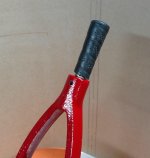Thank you Unclenick.
I didn't know whether the press cams over per se. But based on what I saw on the video, it does seem go rather near the top dead center. That is where my concern is as the mechanical advantage is huge, infinite theoretically. It can break thing before you know it.
Forming a straight wall case is much lighter duty than a full size bottle neck case. When I form 30-06 into 8mm Mauser, I lean on the handle of my t-mag. It cams over. The force exerted on the die is easily several thousand pounds. I know some seasoned reloaders consider using sizing die for forming a "bad habit". Although I don't totally agree with the thought, I can see the point. It is taxing on the equipment.
I see what the co-ax is best at. I should use it judicially, if I decide to buy it. I will put all things into consideration.
Thanks again for your calm and shrewd advice. It has been a pleasure as always.
-TL
I didn't know whether the press cams over per se. But based on what I saw on the video, it does seem go rather near the top dead center. That is where my concern is as the mechanical advantage is huge, infinite theoretically. It can break thing before you know it.
Forming a straight wall case is much lighter duty than a full size bottle neck case. When I form 30-06 into 8mm Mauser, I lean on the handle of my t-mag. It cams over. The force exerted on the die is easily several thousand pounds. I know some seasoned reloaders consider using sizing die for forming a "bad habit". Although I don't totally agree with the thought, I can see the point. It is taxing on the equipment.
I see what the co-ax is best at. I should use it judicially, if I decide to buy it. I will put all things into consideration.
Thanks again for your calm and shrewd advice. It has been a pleasure as always.
-TL
Last edited:


